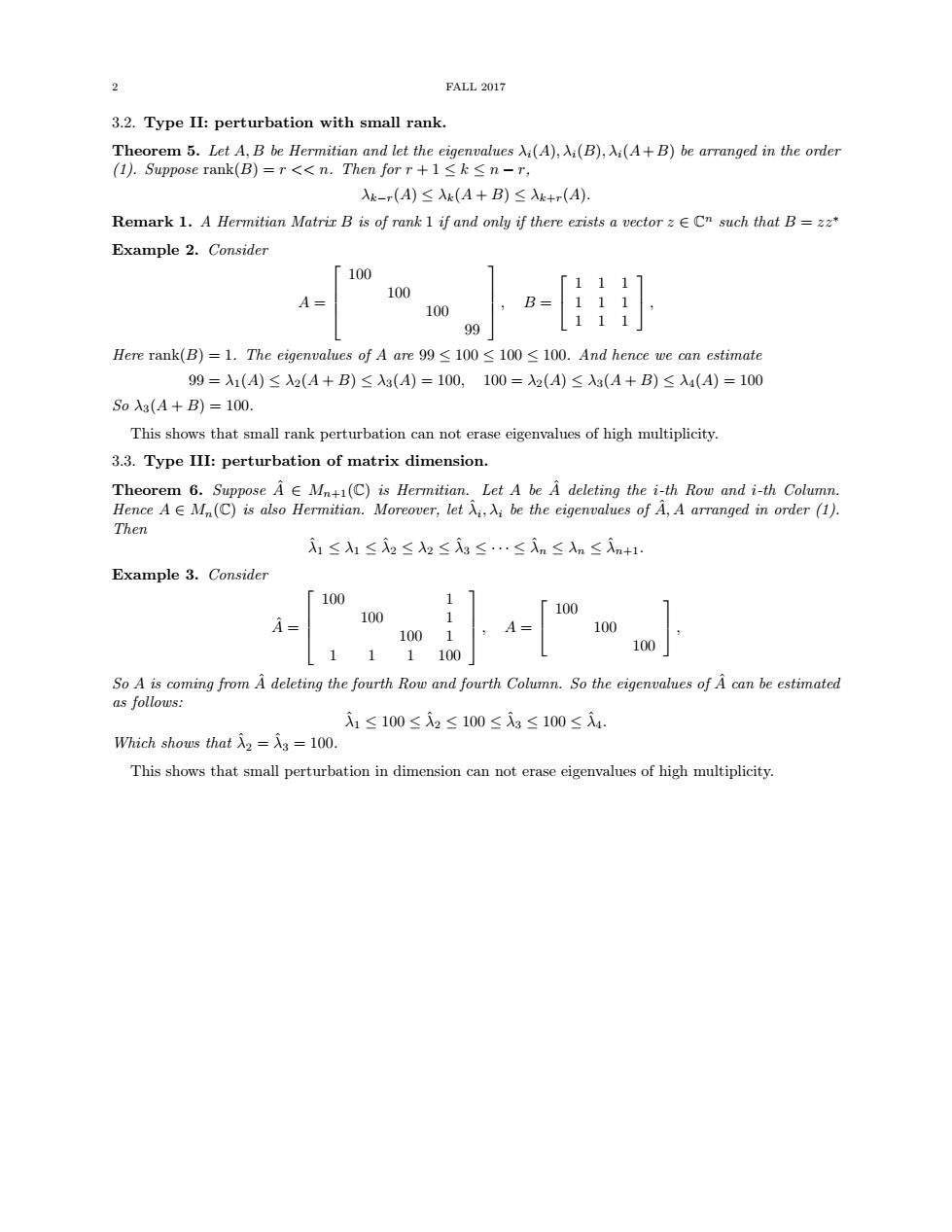正在加载图片...

FALL 2017 3.2.Type II:perturbation with small rank. Theorem 5.Let A,B be Hermitian and let the eigenvalues Ai(A),Ai(B),Ai(A+B)be arranged in the order (1).Suppose rank(B)=r<<n.Then for r+1<k<n-r, 入k-r(A)≤入k(A+B)≤Ak+r(A) Remark 1.A Hermitian Matrix B is of rank 1 if and only if there erists a vector z E Cn such that B=zz* Example 2.Consider 100 100 100 111 Here rank(B)=1.The eigenvalues of A are 99 100100 100.And hence we can estimate 99=X1(A)≤λ2(A+B)≤λ3(A)=100,100=2(A)≤λ3(A+B)≤入4(A)=100 Soλ3(A+B)=100. This shows that small rank perturbation can not erase eigenvalues of high multiplicity. 3.3.Type III:perturbation of matrix dimension. Theorem 6.Suppose A E Mn+1(C)is Hermitian.Let A be A deleting the i-th Row and i-th Column. Hence AE Mn(C)is also Hermitian.Moreover,let Xi,Xi be the eigenvalues of A,A arranged in order (1). Then 入1≤1≤2≤2≤ig≤…≤入n≤m≤Xn+1. Example 3.Consider 100 100 100 100 100 100 1 11 100 So A is coming from A deleting the fourth Row and fourth Column.So the eigenvalues of A can be estimated as follows: 入1≤100≤2≤100≤Xg≤100≤X4. Which shows that入2=入3=100. This shows that small perturbation in dimension can not erase eigenvalues of high multiplicity.2 FALL 2017 3.2. Type II: perturbation with small rank. Theorem 5. Let A, B be Hermitian and let the eigenvalues λi(A), λi(B), λi(A+B) be arranged in the order (1). Suppose rank(B) = r << n. Then for r + 1 ≤ k ≤ n − r, λk−r(A) ≤ λk(A + B) ≤ λk+r(A). Remark 1. A Hermitian Matrix B is of rank 1 if and only if there exists a vector z ∈ C n such that B = zz∗ Example 2. Consider A = 100 100 100 99 , B = 1 1 1 1 1 1 1 1 1 , Here rank(B) = 1. The eigenvalues of A are 99 ≤ 100 ≤ 100 ≤ 100. And hence we can estimate 99 = λ1(A) ≤ λ2(A + B) ≤ λ3(A) = 100, 100 = λ2(A) ≤ λ3(A + B) ≤ λ4(A) = 100 So λ3(A + B) = 100. This shows that small rank perturbation can not erase eigenvalues of high multiplicity. 3.3. Type III: perturbation of matrix dimension. Theorem 6. Suppose Aˆ ∈ Mn+1(C) is Hermitian. Let A be Aˆ deleting the i-th Row and i-th Column. Hence A ∈ Mn(C) is also Hermitian. Moreover, let λˆ i , λi be the eigenvalues of A, A ˆ arranged in order (1). Then λˆ 1 ≤ λ1 ≤ λˆ 2 ≤ λ2 ≤ λˆ 3 ≤ · · · ≤ λˆ n ≤ λn ≤ λˆ n+1. Example 3. Consider Aˆ = 100 1 100 1 100 1 1 1 1 100 , A = 100 100 100 , So A is coming from Aˆ deleting the fourth Row and fourth Column. So the eigenvalues of Aˆ can be estimated as follows: λˆ 1 ≤ 100 ≤ λˆ 2 ≤ 100 ≤ λˆ 3 ≤ 100 ≤ λˆ 4. Which shows that λˆ 2 = λˆ 3 = 100. This shows that small perturbation in dimension can not erase eigenvalues of high multiplicity